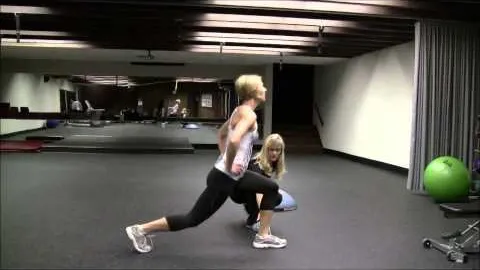
Are you looking for an effective exercise that targets your lower body muscles while improving your balance and stability? Look no further than the Step Back Lunge! This compound exercise is widely popular among fitness enthusiasts and professionals alike, and for good reason. Not only does it engage multiple muscle groups simultaneously, but it also helps develop lower body strength, coordination, and flexibility.
The Step Back Lunge is a versatile exercise that primarily targets the quadriceps, hamstrings, and gluteal muscles. By incorporating this exercise into your fitness routine, you'll reap numerous benefits, including:
Leg strength and toning: The Step Back Lunge places a significant load on the lower body muscles, which promotes muscle growth and overall leg strength. It helps sculpt your quadriceps, hamstrings, and glutes, giving you a more defined and toned look.
Improved balance and stability: Performing Step Back Lunges challenges your balance and stability, as you alternate legs during each repetition. This exercise engages your core muscles and activates the stabilizer muscles in your legs, ultimately enhancing your sense of balance and coordination.
Hip and ankle mobility: Step Back Lunges require a considerable range of motion from your hip and ankle joints. As you step back and lower your body, your hip flexors and ankle muscles are stretched, improving their mobility and flexibility.
Caloric burn: Due to its high intensity, the Step Back Lunge is a great calorie-burning exercise. It elevates your heart rate, contributing to increased cardiovascular endurance and aiding in weight loss.
To properly execute the Step Back Lunge, follow the steps below:
Starting position: Begin by standing straight with your feet shoulder-width apart, and your hands resting on your hips or hanging by your sides.
Step back: Take a big step backward with your left foot, lowering your body until both knees are bent at approximately a 90-degree angle. Make sure your left knee is directly above your left ankle, and your right shin is perpendicular to the floor.
Push down and step forward: Push through your left heel and engage your quadriceps and glutes to return to the starting position. Step your left foot forward to meet your right foot.
Repeat on the other side: Repeat the same movement, this time stepping back with your right foot, ensuring proper form and alignment. Alternate sides for the desired number of repetitions.
To maximize the benefits of the Step Back Lunge and prevent injury, keep the following tips in mind:
Once you have mastered the basic form, you can make the Step Back Lunge more challenging and diverse by incorporating these variations:
Weighted Step Back Lunge: Hold dumbbells or kettlebells in each hand or use a barbell across your upper back to increase the resistance and intensity of the exercise.
Curtsy Lunge: Instead of stepping directly backward, cross your trailing leg behind your front leg in a curtsy motion. This variation specifically targets your gluteal muscles.
Forward Lunge: Instead of stepping backward, step forward with one foot to perform a forward lunge. This variation slightly shifts the emphasis to your quads and challenges the muscles differently.
Dumbbell Walking Lunge: Perform Step Back Lunges while walking forward. This variation adds a dynamic element to the exercise, engaging your leg muscles and cardiovascular system even more.
To effectively incorporate the Step Back Lunge into your fitness routine, consider the following guidelines:
The Step Back Lunge is a highly effective exercise for enhancing lower body strength, balance, and stability. By incorporating this compound movement into your routine, you'll not only target various muscle groups but also enjoy the benefits of increased mobility, improved balance, and caloric burn. Remember to prioritize proper form, progress at your own pace, and consult a fitness professional if needed. So gear up, and take a step back towards a stronger, healthier you!
If you're looking for a gym, fitness club or yoga studio, you've come to the right place.
You can find information about gyms in your area. Browse catalog of gyms and find gyms with classes which are you looking for.
On gym page you can find simple information like address, phone or website. You can find list of available classes. You can check availability of personal training or small group classes. On place page you can also see information about open hours.
You can find gyms near you with amenities, courts, studios and equipments.
Use our map to find gym at your city or district.
In Gym Navigator you can find list of exercises with movies for many body parts.
You can browse exercises catalog and find exercises the best of you.
You can also find exercises grouped into workout plans, which you can use to improve you body. Each routine show you exercises one by one and give you possibility to count you progress and count down rest time.